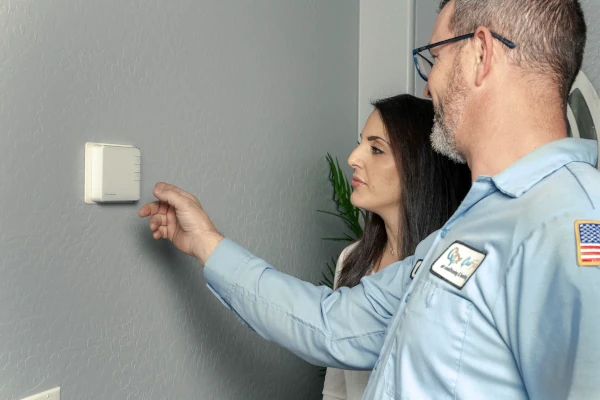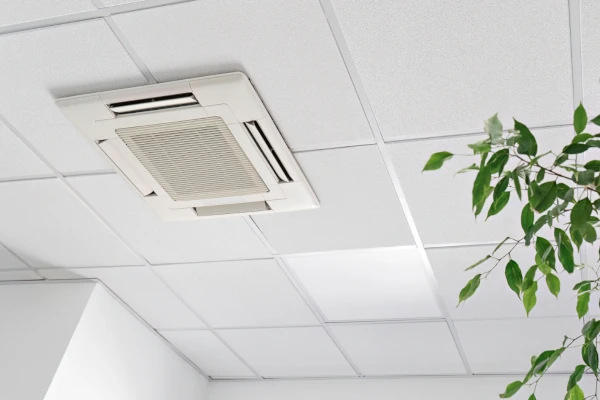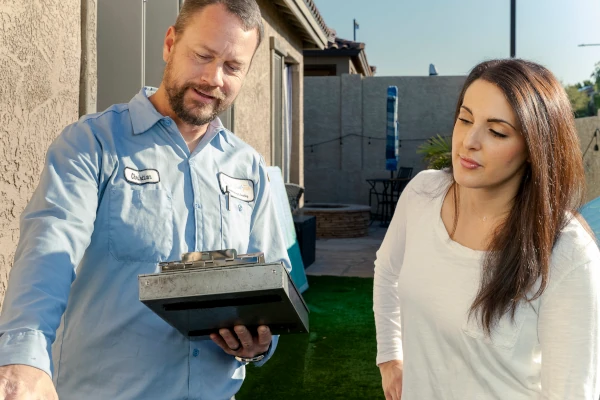In Maricopa County, Arizona, extreme summer heat dominates the year, while winter cold is brief and mild. Unlike other regions, where heating and cooling needs are more balanced, residents here depend almost entirely on air conditioning. Setting the right thermostat temperature is key for comfort, cost savings, and energy efficiency.
Whether you’re working from home, sleeping, caring for pets or plants, or keeping a baby safe, indoor temperature plays a major role. With high electricity costs and sustainability concerns, knowing the ideal settings can keep your home comfortable without wasting energy. This guide covers the best thermostat temperatures for different needs, helping you stay cool and efficient in Arizona’s desert climate.
What's The Best Setting To Save on Cooling Costs?
The best thermostat temperature for energy savings in Arizona is 78°F in summer when you’re home. When you’re away, raising it to 83°F reduces cooling costs without excessive heat buildup. Using a programmable or smart thermostat makes these adjustments automatic, ensuring comfort when you return while maximizing savings. Ceiling fans can also help you feel cooler, allowing you to keep the thermostat higher without sacrificing comfort.
Are The Energy Savings Worth It?
 According to the U.S. Department of Energy (DOE), raising your thermostat by 7-10°F for 8 hours a day can save up to 10% annually on cooling costs. While the DOE notes that savings are greater in milder climates, Arizona’s extreme heat means cooling costs make up a larger share of total energy use. Even though the percentage savings may be lower, the absolute dollar savings can be substantial because air conditioning runs for much of the year. For an average Arizonan household, this will save up to $15 a month.
According to the U.S. Department of Energy (DOE), raising your thermostat by 7-10°F for 8 hours a day can save up to 10% annually on cooling costs. While the DOE notes that savings are greater in milder climates, Arizona’s extreme heat means cooling costs make up a larger share of total energy use. Even though the percentage savings may be lower, the absolute dollar savings can be substantial because air conditioning runs for much of the year. For an average Arizonan household, this will save up to $15 a month.
The Department of Energy also says that raising thermostat temperature 1 Degree will reduce cooling costs by 3%. This means that raising your thermostat from 72°F to 78°F can save about 18% on cooling costs. In Arizona, this could result in savings of approximately $27 per month on the average electricity bill. These savings are especially impactful during peak cooling months, where air conditioning makes up a significant portion of energy use.
Additional steps like sealing leaks, using blackout curtains, and maintaining your HVAC system further improve efficiency. Smart thermostats can also help by learning your schedule and making automatic adjustments.
What's The Best Thermostat Temperature For Working From Home?
Many people now work from home, which means creating an environment that promotes productivity is more important than ever. One key factor in this is the temperature of your workspace. The ideal thermostat setting for most people working from home is between 72°F and 74°F. This range strikes the perfect balance between comfort and focus, helping to keep you alert and productive without becoming too warm or too cold.
Research shows that 72°F-74°F is ideal for concentration, as it keeps you cool enough to stay focused without becoming sluggish. However, some people may perform better at slightly warmer or cooler temperatures based on personal preference. If you tend to feel chilly or hot easily, adjusting within a few degrees of this range can still be effective for your work environment. It’s important to test different settings to find the temperature that helps you perform at your best.

What's The Best Thermostat Temperature for Sleep?

The best temperature for sleeping is generally between 68°F-70°F. This range promotes deeper sleep by helping regulate your body’s internal temperature, creating an optimal environment for rest.
Cooler thermostat temperatures encourage the body to relax and enter the deeper stages of sleep. A comfortable sleep environment improves overall sleep quality and reduces nighttime wakefulness, promoting better rest and recovery. Experts recommend settings between 60°-70°, but temperatures below 68° can cause extra moisture and could result in biological growth in the home’s structure.
Elderly individuals may prefer slightly warmer temperatures, around 68°F-77°F, as they tend to be more sensitive to cold. Additionally, individuals with medical conditions may have unique temperature preferences and should adjust accordingly to ensure comfort and restful sleep.
What's The Best Temperatures for Babies?
The best thermostat temperature for babies is generally 68°F-72°F. This range helps babies sleep comfortably and safely while avoiding overheating or chilling. It’s crucial to avoid making the room too hot, as overheating can increase the risk of sudden infant death syndrome (SIDS).

Why is it so Important?
Babies are particularly sensitive to temperature due to their smaller body size and less-developed ability to regulate body heat. They lose heat quickly and have underdeveloped sweat glands. Signs that your baby is too hot include sweating, flushed skin, rapid breathing, or damp hair, while signs of being too cold include cold hands or feet, pale skin, shivering, or fussiness. Keeping the room within the ideal range helps ensure safe sleep and reduces the risk of health issues.
What's The Best Thermostat Temperature for Pets?
The best temperature for pets is usually between 65°F-75°F. This range keeps most pets comfortable, though some animals have more specific needs. Monitoring your pet’s behavior and adjusting the temperature can help ensure they remain content. Here’s a list of some animals with their preferred temperature ranges, as well as how flexible they are. Note that most animals have similar ranges to humans, except for rabbits, and reptiles.
Dogs: 65°F-75°F (most dogs are adaptable)
Cats: 65°F-75°F (generally flexible)
Fish: We do Air Conditioning.
Reptiles: 70°F-85°F 85°F-100°F for Basking Spots (picky, differs by species,)
Birds: 65°F-80°F (sensitive to drafts and temperature fluctuations)
Rabbits: 55°F-72°F (sensitive to heat)
Hamsters: 65°F-75°F (moderate, avoid overheating)


What's The Best Temperature for Houseplants?
The best thermostat temperature for houseplants typically ranges from 60°F to 75°F. Most houseplants thrive in moderate warmth, with cooler temperatures at night. Tropical plants prefer warmer conditions, while succulents and cacti tolerate slightly cooler temperatures. Consistency is key to preventing stress and encouraging healthy growth. Here’s a few houseplant’s preferred temperatures.
Spider Plants: 60°F-75°F (adaptable, but avoid drafts and extreme heat)
Snake Plants: 60°F-85°F (tolerant of a range of temperatures, but avoid cold drafts)
Peace Lilies: 65°F-80°F (prefer warmth, but can tolerate slightly cooler temperatures)
Fiddle Leaf Fig: 60°F-75°F (prefer consistent warmth, sensitive to cold)
Succulents: 60°F-80°F (can handle warmer temperatures, but avoid overheating)
Cacti: 65°F-85°F (adaptable, but enjoy warmer, dry conditions)
Pothos: 65°F-85°F (tolerant of a wide range but prefers warmth)
What's The Right Temperature for Me?
Finding the best thermostat settings in Maricopa County is essential for comfort, energy efficiency, and overall well-being. Whether you’re working, sleeping, caring for pets, plants, or babies, temperature plays a crucial role. Keeping your home at 78°F for efficiency, 72°F-74°F for productivity, and 68°F-72°F for sleeping and infants strikes a good balance. Adjustments can be made based on individual needs, or specific pets like lizards or bunnies, but small changes can lead to significant energy savings. A programmable thermostat helps automate these settings, ensuring comfort while reducing costs. By fine-tuning your home’s temperature, you can stay cool in the desert heat without wasting energy. If you’d like to upgrade or fix your thermostat reach out to us below, or take a look at our thermostat page for more details.





